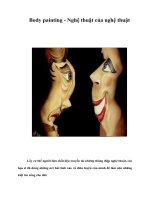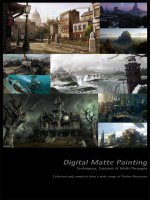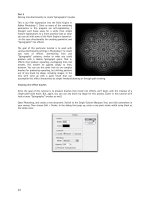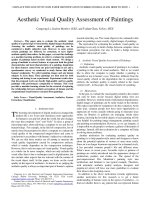Chinese painting
Bạn đang xem bản rút gọn của tài liệu. Xem và tải ngay bản đầy đủ của tài liệu tại đây (17.99 MB, 168 trang )
Chinese Painting
Chinese Painting
Mario Bussagli
Paul Hamlyn
LONDON NEW YORK SYDNEY
•
•
•
JORONTO
Translated by Henry
La
©
1966
'idon from the Italian original
\
Pittura Cinese
Frate Hi
Fabbri Editori, Milan
This edition
©
1969
The Hamlyn Publishing Group Timited
Hamlyn House,
The Centre, Feltham,
Middlesex
Text film set
in
Great Britain by Yendall (& Co. Ltd,
London
Printed in Italy by Fratelli Fabbri Editori,
Milan
Outside Europe, there
is
no
livelier, richer
or more
technically accomplished tradition of painting than
that of China.
Chinese painting has for a long time attracted attention in the West, not continuously, perhaps, and par-
be instinctively but wrongly
compared with Western standards of technique and
ticularly at first only to
composition.
Marco Polo, astonished observer of Cathay, the
China of the Mongols, tells us nothing about the great
Chinese painters then living, unlike Father Matteo
Ricci (1552-1610) who, in January 1 60 1 arrived at the
court of Peking as the first Catholic missionary. Yet,
while praising Chinese artists for their extraordinary
natural talent, Ricci declared that they could not compete with Europeans because 'they do not know how
to paint in oils or give shadows to what they depict'.
For generations, the main charge against Chinese
painters, and those of other Asian schools as well, was
,
Giuseppe Castiglione (LangShih-nmg) (1 698-1 768).
The Ambassadors of the Kazak Kirghiz presenting Two
Horses to the Emperor Ch'ien-lung (detail). Ch'ien-lung
period. Musee Guimet, Paris.
1
.
Giuseppe Castiglione (Lang Shih-ning) (1698-1768).
The Ambassadors of the Kazak K/rgh/z presenting Two
Horses to the Emperor Ch'ien-lung (detail). Ch'ien-lung
period. IVlusee Guimet, Paris.
2.
Giuseppe Castiglione (Lang Shih-ning) (1698-1768).
The Ambassadors of the Kazak Kirghiz presenting Two Horses
tothe Emperor Ch'ien-lung (detail). Ch'ien-lung period. Musee
Guimet, Paris.
1.
Giuseppe Castiglione (Lang Shih-ning) (1698-1768).
The Ambassadors of the Kazal< Kirghiz presenting Two Horses
tothe Emperor Ch'ien-lung (detail). Ch'ien-lung period. Musee
2.
Guimet,
In
these
Paris.
two
portraitist
pictures the Milanese painter shows his ability as a
and applies Western rules of perspective to the
architecture.
Nighur Princess offering a Gift. Votive picture on canvas
dated ad.983. From Tun-huang. P. Pelliot Collection,
3.
Musee Guimet,
Paris.
Nighur Princess offering a Gift. Votive picture on canvas
dated ad 983. From Tun-huang. P. Pelliot Collection, Musee
Guimet, Paris. An example of Chinese influenced central
Asiatic painting. Note how the figures of the women dominate
the featureless room but without any psychological implication.
3.
Horseman and Groom. Painting on paper from Tunhuang. 8th century. Musee Guimet, Paris. The central Asiatic
taste is clearly seen in the figures of the horses and the sketchy
background.
4.
4.
Horseman and Groom. Painting on paperfrom Tun-huang.
Musee Guimet, Paris.
8th century.
11
know how to use scientific perspecthus ignored the fact that there were other
ways, equally valid if less realistic, of showing perthat they did not
tive. Critics
spective.
During the 17th and i8th centuries, contacts
between Europe and China intensified progressively,
and a number of missionary priests at the imperial
court, mostly Italian or French, who happened to be
painters as well, tried to spread Western technique and
Western sensibility. Nobles, literati, senior officials,
even the emperor himself showed interest in the realism obtainable by the Western handling of perspective.
To satisfy their curiosity, a certain Father Buglio
a treatise on the subject in Chinese. But its
readers clung to their belief that scientific perspective
was only an exotic novelty. There were too many
differences between European and Chinese painting
wrote
to allow the treatise a
more profound
effect.
Typical of Chinese thinking were the views expressed by
Li (163 2- 1 71 5). For this famous critic
and good connoisseur of European painting, the West
sought too much to render 'the external appearance
and relief of forms', and he rebuked Westerners for
exaggerated use of light and shade in their continual
striving after effect in perspective and chiaroscuro.
To some extent, perhaps, these views were shared
by Lang Shih-ning as he came to be called Father
Giuseppe Castiglione, the distinguished Milanese
priest-painter who laboured in China from 171 5 to
Wu
—
12
1768. The Emperor Ch'ien-lung deemed him the
leading portrait-painter. Yet- the Italian admired
Chinese pictures for their rare refinement and power
of expression. So much so, in fact, that he set out
wholeheartedly to reconcile the opposing tendencies
of East and West. He finally adopted a technique that
was more Chinese than European. Moreover, his
grasp of Chinese technique won him the reputation,
which he still enjoys even among local critics, of being
one of the great Chinese masters.
From what we have discussed so far, it is evident
that, looked at with too Western an eye, Chinese
paintings yield neither their beauty nor their secrets.
Apart from the mania for chinoiseries and the admiration displayed throughout the i8th century for the
minute perfection and exotic curiosity of Chinese
craftsmanship, we have to jump to the second half of
the Victorian era and slightly beyond for the first
signs of genuine scientific interest in Chinese paintings. And that stemmed chiefly from the interest taken
in Japanese prints, those beautiful creations that
played no small part in the profound change in painting which occupied the European art world in the
second half of the 19th century. Yet, even then, it
could not be said that the West had forced itself to a
proper appreciation of the immense heritage of art
and poetry— offered by Chinese painting. Beyond the
—
restricted circle of specialists, that arfremained almost
unknown
or, at best, appreciated
by people whose
13
hazy if not erroneous ideas stemmed from an unavowed taste for the exotic. When all is said and done^
Chinese painting is still often seen with Western eyes
and still regarded as some sort of whimsical negation
of. our Western standards.
The misconception to which this approach gave
rise has been accentuated by the fact that the first notable Western scholars echoed Japanese evaluations
and relied on the latest Chinese critical texts. Consequently they applied traditional methods of evaluation to paintings and schools which, to be judged
properly, should first have been accurately dated, so
as to set them firmly into the period when they were
created.
not long since we have become aware of this
error. Osvald Siren admitted it openly and in 1958
brought out a completely rewritten edition of his
colossal work on Chinese painting. That he should
have undertaken such a task shows how determined
this great scholar was to understand and judge accurately the aesthetic aims of a large number of artists.
And yet, despite all the difficulties in forming judgments and the need for background knowledge if one
is to understand it clearly, Chinese painting is not as
foreign to the Western world as it might seem.
Bernard Berenson pointed out that occasionally the
spirit of Chinese painting has a counterpart in our
own, in the Sienese school of the 14th century and the
first decades of the 1 5 th, caused by the emotional and
It is
14
mystical drive of the Sienese people. Now, Berenson
was thinking of a spiritual affinity rather than an historical connection, but it is not beyond the bounds of
possibility that paintings of the Sung or very early
Yiian could have suggested to Simone Martini something more than the dimensions of his great fresco in
the Palazzo Pubblico of Siena representing Guidoriccio da Fogliano at the siege of Montemassi. The
very treatment of the landscape, perhaps, of the
palisade and of the flags and lances betrays here the
presence of an army which
we cannot
Leaving
animated
Simone's work a clear expression of medieval
Italian sensibility
the fact remains that the proportions of the fresco correspond to those of a Chinese
hand scroll, the height being one third of the width.
Moreover, details correspond and, yet another factor
to point to imitation, Simone works them out just as
Chinese artists would have done. To see the likelihood
of such a derivation one need only compare Simone's
fresco with the scroll by Chao Po-chii in the Boston
Museum of Fine Arts. (Chao Po-chii was a Sung
painter of imperial blood active about the middle of
aside
the
greatly
different
spirit
see.
that
—
—
the
1
2th century.)
do not intend now to reopen the complex, badly
formulated and hastily resolved question of a relationship between the Sienese school and Far Eastern art.
Nor do I wish to re-examine that other, more likely
hypothesis— the influence of Chinese iconography on
I
15
5.
Chao Meng-fu (1254-1322)
(attribution uncertain).
Picture ofWang-ch'uan. Copy of the landscape by
Yuan dynasty. British Museum, London.
6.
Wu
Wang
Chu Tuan (active 1 506-1 521 ). River Landscape.
Tsung period. National Museum, Stockholm.
Wei.
17
7.
Chu
Jui (attributed). Detail of a scroll illustrating
the poem of Su Tung-p'o, The Red Rocky Precipice.
National Palace and Central Museum Collections, Taichung
(Taiwan).
Chao Meng-fu
5.
(1254-1322)
(attribution
uncertain).
Picture of Wang-ch'uan. Copy of the landscape by Wang Wei.
Yuan dynasty. British Museum, London. Done for the purposes
of study, this is a copy of a famous work by a painter already
master of style but independent as regards the content.
6.
Chu Tuan (active 1506-1521). River Landscape. Wu
Tsung period. National Museum, Stockholm. A fine evocative
example of vertical composition with rocks, houses, trees,
waterfalls and human beings in a clearly Chinese landscape.
Chu
7.
Jui (attributed). Detail of a scroll illustrating the
Su Tung-p'o, Ttie Red Rocl
The overhanging effect of the rocks above the waters of the
river is rendered from a viewpoint which makes good use of the
mist, the clumps of vegetation and the vertical erosion.
poem
of
Ma Lin (c. 1 220) (attributed). Birds and Thorn Blossom.
Sung dynasty. National Museum, Tokyo. Although only a small
8.
detail in a lively landscape, the colours of this vignette
a
mood. Hanging
scroll in ink
and colour on
suggest
silk.
19
8.
Ma
Lin
(c.
1
220) (attributed). Birds and Thorn Blossom.
Sung dynasty. National Museum, Tokyo.
medieval European art. All I want to say is that the
East-West link is confirmed by other
landscape details in works by Simone Martini.
Well attested commercial and cultural relations
between Europe and the Far East from the mid 1 3th
to the mid 14th centuries make the possibility of such
a link seem all the more acceptable. Chinese art may
well have suggested this or that exotic detail to the
great Sienese painter. It may well have influenced his
approach to painting and that of other Italians too,
offering them something new by way of composition,
iconography and even style.
The hypothesis is diflRcult to substantiate and for
many diflficult to accept. But even if it were shown to
be false, there would still remain that world of painting so rich, refined and varied, a peerless interpreter
of moods, landscapes and the tiniest details in nature,
a world that tempts us to make the effort necessary to
understand it.
The- effort is well worthwhile, and I have written
these pages with the precise object of helping you draw
as close as you can to that world and its delights.
In the Chinese scale of aesthetic values top priority
was given to calligraphy, painting, poetry and music.
Partly because the materials employed were of small
value and the things created heavy, architecture and
sculpture were considered work for workmen. And
possibility of an
the same applies to the minor arts where patient craftsmanship precluded immediacy of expression, the one
21









